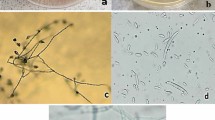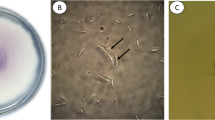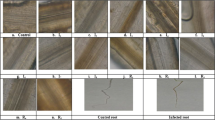Abstract
Bakanae is the emerging disease threating the rice cultivation globally. Yield reduction of 4–70% is recorded in different parts of the world. A total of 119 Fusarium isolates were collected from rice plants at different geographical locations and seeds of different rice cultivars. The isolates were evaluated for morphological, biochemical and pathogenic diversity. The amplification of TEF-1α gene was carried out for exploring the species spectrum associated with the cultivated and pre-released rice varieties. The production of gibberellin varied from 0.53 to 2.26 µg/25 ml, while as that of Indole acetic acid varied from 0.60 to 3.15 µg/25 ml among the Fusarium isolates. The phylogenetic analysis identified 5 different species of the genus Fusarium viz. Fusarium fujikuroi, F. proliferatum, F. equiseti, F.oxysporum and F. persicinum after nucleotide blasting in NCBI. Only two Fusarium spp. F. fujikuroi and F. proliferatum were found to be pathogenic under virulence assays of the isolates. The isolates showed a considerable variation in morphological and pathogenic characters. The isolates were divided into different groups based on morphology and pathogenicity tests. The isolates showed a considerable variation in morphology, phytohormone profile and virulence indicative of population diversity. Three species F. equiseti, F.oxysporum and F. persicinum which have not been reported as pathogens of rice in India were found to be associated with bakanae disease of rice, however their pathogenicity could not be established.


Similar content being viewed by others
References
Dwivedi S (2016) Identification of QTLs for coleoptile length in rice (Oryza sativa L.). Dissertation, Indra Gandhi Krishi Vishwavidyalaya, Raipur
USDA. FAS (2018). https://apps.fas.usda.gov/newgainapi/api/report/downloadreportbyfilename?filename=Grain%20and%20Feed%20Annual_New%20Delhi_India_3-16-2018.pdf
Kumar PMK, Gowda DKS, Rishikant MN, Kumar KT, Pandurange G, Vishwanath K (2013) Impact of fungicides on rice production in India. In: Nita M (ed) Fungicides-showcases of integrated plant disease management from around the world. Intech Open, Viena, pp 77–98
Sharma VK, Thind TS (2007) Rice diseases: ecology and control. In: Pimentel D (ed) Encyclopedia of pest management. CRC Press, Florida, pp 556–561
Hori S (1898) Some observations on bakanae disease of the rice plant. Memb Agric Res Stn 12:110–119
Sawada K (1917) Beitrage uber Formosas-Pilze no.14. . Trans Nat Hist Soc Formosa 31:131–133
Ito S, Kimura J (1931) Studies on the bakanae disease of rice plant. Report Hokkaido Natl Agric Exp Stn 27:1–95
Naeem M, Iqbal M, Parveen N, Sami-Ul-Allh AQ, Rehman A, Shauket MS (2016) An overview of bakanae disease of rice. Am Eurasian J Agric Environ Sci 16(2):270–277
Singh R, Sunder S (1997) Foot rot and bakanae of rice: retrospects and prospects. Intern J Trop Plant Dis 15:153–176
Bashyall BM, Aggarwal R, Rawat K, Sharma S, Gupta AK et al (2020) Genetic diversity and population structure of Fusarium fujikuroicausing bakanae, an emerging disease of rice in India. Indian J Exp Biol 8:45–52
Singh R, Sunder S (2012) Foot rot and bakanae of rice: an overview. Reviews Plant Pathol 5:565–604
Bashyal BM, Aggarwal R (2013) Molecular identification of Fusarium spp. associated with bakanae disease of rice in India. Indian J Agric Sci 83(1):72–77
Wulff EG, Sorensen JL, Lubeck M, Nielsen KF, Thrane U, Torp J (2010) Fusarium spp. associated with rice bakanae: ecology, genetic diversity, pathogenicity and toxigenicity. Environ Microbiol 12(3):649–657
Amatulli MT, Spadaro D, Gullino ML, Garibaldi A (2010) Molecular identification of Fusarium spp. associated with bakanae disease of rice in Italy and assessment of their pathogenicity. Plant Pathol 59:839–844
Alberman SL, Tudzynski P, Bettina (2013) Strategies for strain simprovement in Fusarium fujikuroi: overexpression and localization of key enzymes of the isoprenoid pathway and their impact on gibberellin biosynthesis. Appl Microbiol Biotechnol 97(7):2979–2995
Stud L, Humpf HU, Tudzynski B (2013) Signaling governed by G proteins and cAMP is crucial for growth, secondary metabolism and sexual development in Fusarium fujikuroi. PLoS ONE 8(2):e58185
Tudzynski B (1999) Biosynthesis of gibberellins in Gibberella fujikuroi: Bimolecular aspects. Appl Microbiol Biotechnol 52:298–310
Philip W, Albermann S, Niehaus EM, Studt L, von-Bargen KW, Brock NL et al (2012) The Sfp-Type 4′-Phosphopantetheinyl Transferase Ppt1 of Fusarium fujikuroi controls development, secondary metabolism and pathogenicity. PLoS ONE 7(5):e37519
Rajagopalan K, Bhuvaneswari K (1964) Effect of germination of seeds and host exuadations during germination on foot-rot disease of rice. J Phytopathol 50(3):221–226
Desjardins AE (2006) Fusarium mycotoxins: chemistry, genetics, and biology. APS Press, St. Paul
Geiser DM, Jimnez-Gasco MDM, Kang S, Makalowska I, Veereraghawan N, Ward TJ, Zhang N, Kuldau GA, O’Donnell K (2004) FUSARIUM-ID v. 1.0: A DNA sequence database for Identifying Fusarium. Eur J Plant Pathol 110:473–479
Matheny PB, Wang Z, Binder M, Curtis JM, Lim YW, Nilsson RH, Hughes KW, Hofstetter V, Ammirati JF, Schoch CL, Langer E, Langer G, McLaughlin DJ, Wilson AW, Froslev T, Ge Z, Kerrigan RW, Slot JC, Yang Z, Baroni TJ, Fischer M, Hosaka K, Matsuura K, Seidl MT, Vauras J, Hibbett DS (2007) Contributions of rpb2 and tef1 to the phylogeny of mushrooms and allies (Basidiomycota, Fungi). Mol Phylogenet Evol 43:430–451
Olal S, Olango N, Kiggundu A, Ochwo S, Adriko J, Nanteza A, Matovu E, Lubega GW, Kagezi G, Hakiza GJ, Wagoire WW, Rutherford MA, Opiyo SO (2018) Using translation elongation factor gene to specifically detect and diagnose Fusarium xylaroides, a Causative Agent of Coffee Wilt Disease in Ethiopia, East and Central Africa. J Plant Pathol Microbiol 9:6
Gupta AK, Solanki IS, Bashyal BM, Singh Y, Srivastav K (2015) Bakanae of rice: an emerging disease in Asia. J Anim Plant Sci 25(6):1499–1514
Miles SR (1963) Handbook of tolerances and measures of precision for seed testing. Proc Int Seed Test Assoc 28(3):644
Nelson PE, Toussoun TA, Marasas WFO (1983) Fusarium species: an illustrated manual for identification. The Pennsylvania State University Press, USA
Murray MG, Thompson WF (1980) Rapid isolation of high molecular weight plant DNA. Nucleic Acid Res 8:4321–4325
O’Donnell K, Kistler HI, Cigelnik E, Ploetz RC (1998) Multiple evolutionary origins of the fungus causing Panama disease of banana: concordant evidence from nuclear and mitochondrial gene genealogies. Proc Natl Academy Sci USA 95:2044–2049
Thompson JD, Higgins DG, Gibson TJ (1994) CLUSTALW: improving the sensitivity of progressive multiple sequence alignment through sequence weighting, position specific gap penalties and weight matrix choice. Nucleic Acids Res 22:4673–4680
Kumar S, Stecher G, Tamura K (2016) MEGA7: molecular evolutionary genetics analysis version 7.0 for bigger datasets. Mol Biol Evol 33:1870–1874
Bashyal BM, Aggarwal R, Sharma S, Gupta S, Rawat K, Singh D, Krishnan SG (2016) Occurrence, identification and pathogenicity of Fusarium spp. associated with bakanae disease of basmati rice in India. Eur J Plant Pathol 144(2):457–466
Li DJ, Luo K (1997) Study of the relationship between the occurrence of bakanae disease in hybrid rice and the application of gibberellins to seed reproduction. J Human Agric Univers 23:47–49
Yang CD, Guo LB, Li XM, Ji ZJ, Ma LY, Qian Q (2006) Analysis of QTLs for resistance to rice bakanae disease. Chin J Rice Sci 20:657–659
Suga H, Arai M, Fukasawa E, Motohashi K, Nakagawa H, Tateishi H et al (2019) Genetic differentiation associated with fumonisin and gibberellin production in Japanese Fusarium fujikuroi. Appl Environ Microbiol 85:e02414-e2418
Lone ZA, Bhat ZA, Najeeb S, Ahanger MA, Shikari AB, Parray GA, Hussain S (2016) Screening of rice genotypes against bakanae disease caused by Fusarium fujikuroi Nirenberg. Oryza 53(1):91–97
Leslie JF, Summerell BA (2006) The Fusarium laboratory manual. Blackwell Publishing, Ames, Iowa
Zainudin NAIM, Razak AA, Salleh B (2008) Bakanae disease of rice in Malaysia and Indonesia: etiology of the causal agent based on morphological, physiological and pathogenicity characteristics. J Plant Prot Res 48:475–485
Snyder WC, Hansen HN (1945) The species concept in Fusarium with reference to discolor and other sections. Am J Bot 32:657–666
Booth C (1971) The genus Fusarium. CMI, Kew Surrey, England, pp 1–237
Nirenberg HI (1976) Untersuchungen uber die morphologische und biologische differenzierung in Fusarium-Sektion Liseola. Mitt Biol Bundesansi Land-Forstwirtsch Berlin Dahlem 169:1–117
Ou SH (1987) Rice diseases. England, CAB International, CMI, Kew, Surrey, p 256
Amatulli MT, Spadaro D, Gullino ML, Garibaldia A (2010) Molecular identification of Fusarium spp. associated with bakanae disease of rice in Italy and assessment of their pathogenicity. Plant Pathol 59:839–844
Ou SH (1985) Rice diseases. CMI, Kew, UK
Summerell BA, Salleh B, Leslie JF (2003) A utilitarian approach to Fusarium identification. Plant Dis 87:117–128
Marasas WFO, Thiel PG, Rabie CJ, Nelson PE, Toussoun TA (1986) Monilformin production in Fusarium section Liseola. Mycologia 78:242–247
Desjardins AE, Manandhar HK, Plattner RD, Anandhar GG, Poling SM, Maragos CM (2000) Fusarium species from Nepalese rice and production of mycotoxins and gibberellic acid by selected species. Appl Environ Microbiol 63(3):1020–1025
Proctor RH, Desjardins AE, Moretti A (2010) Biological and chemical complexity of Fusarium proliferatum. In: Strange RN, Gullino ML (eds) The role of plant pathology in food safety and food security in the 21st century. Springer, The Netherlands, pp 97–111
Cumagun CJR, Arcillas E, Gergon E (2011) UP-PCR analysis of the seedborne pathogen Fusarium fujikuroi causing bakanae disease in rice. Int J Agric Biol 13:1029–1032
Chen K, Any QC (2006) Transcriptional response to gibberellin and abscisic acid in barley aleuron. J Integr Plant Biol 48:591–612
Anonymous (1988) Irtp, pp 54, IRRI, Manila
Acknowledgements
The authors are highly thankful to Dean, Faculty of Agriculture, SKUAST-Kashmir, for providing necessary facilities for conducting the research work and for his valuable suggestions during the course of study.
Author information
Authors and Affiliations
Contributions
Conceptualization: F. A. Mohiddin, Rukhsanah Majid, Ashraf Ahanger and Asif B. Shikari. Methodology: F. A. Mohiddin, Aflaq Hamid and Ashraf Ahanger. Formal analysis and investigation: Rukhsanah Majid, F. A. Mohiddin, Arif Hussain Bhat, M. S. Dar & Sajad-un-Nabi. Writing—original draft preparation: Rukhsanah Majid and F. A. Mohiddin. Writing—review and editing: Arif Hussain Bhat and F. A. Mohiddin. Resources: Najeebur Rehman, Ashaq Hussain and N. A. Bhat. Supervision: F. A. Mohiddin, Ashraf Ahanger and F. A. Bhat.
Corresponding author
Ethics declarations
Conflicts of interest
All authors declare they have no conflicts of interest.
Additional information
Publisher's Note
Springer Nature remains neutral with regard to jurisdictional claims in published maps and institutional affiliations.
Rights and permissions
About this article
Cite this article
Mohiddin, F.A., Majid, R., Bhat, A.H. et al. Molecular phylogeny, pathogenic variability and phytohormone production of Fusarium species associated with bakanae disease of rice in temperate agro-ecosystems. Mol Biol Rep 48, 3173–3184 (2021). https://doi.org/10.1007/s11033-021-06337-6
Received:
Accepted:
Published:
Issue Date:
DOI: https://doi.org/10.1007/s11033-021-06337-6




